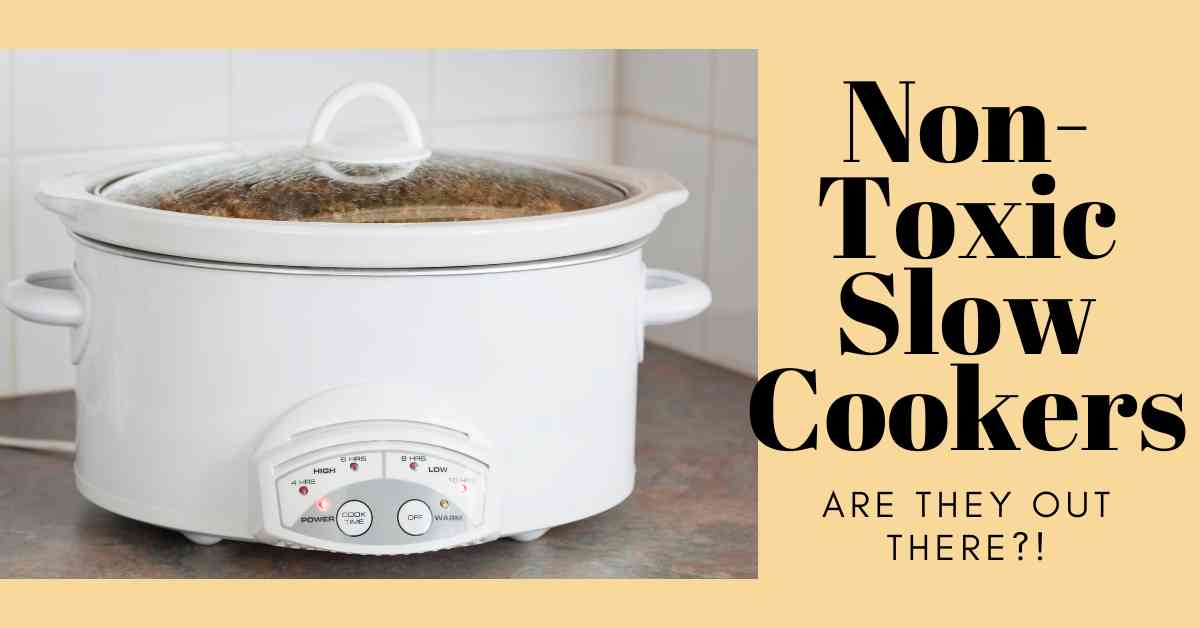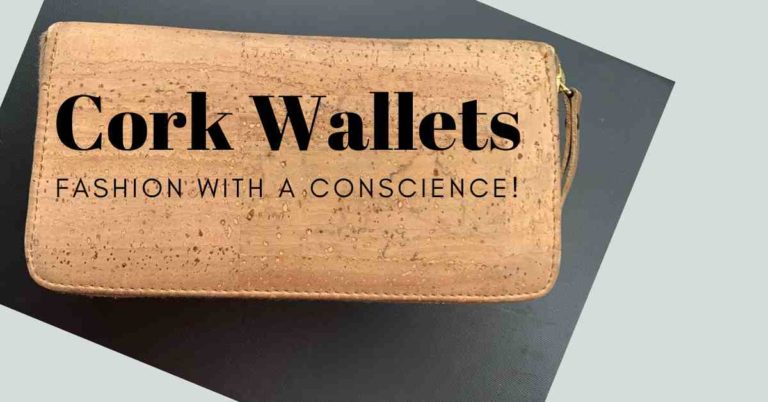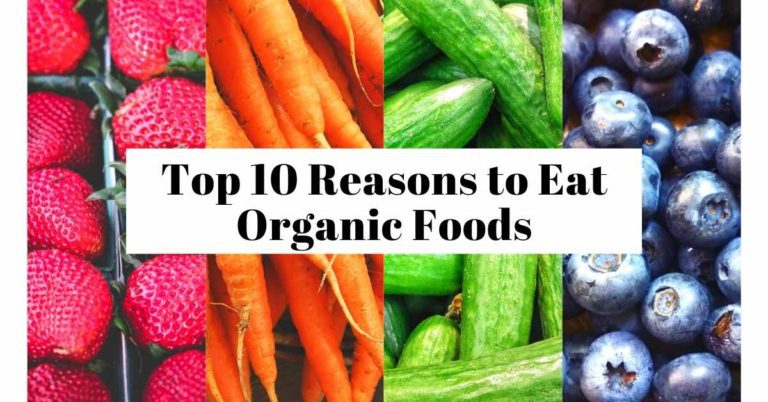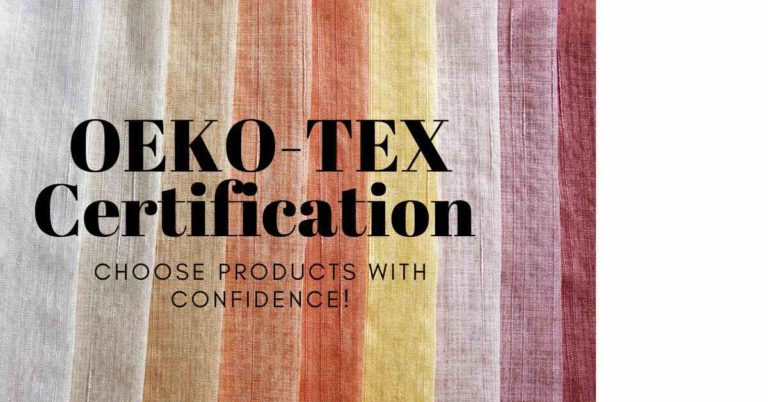Non-Toxic Slow Cookers: Are they out there?!
This post contains affiliate links, which means I receive a small commission, at no extra cost to you, if you make a purchase using this link. Please see my disclaimer for more details. Your purchase helps support my work in bringing you information about non-toxic living.
Are you looking for a safe and non-toxic slow cooker? When choosing a slow cooker, it’s important to consider the materials it’s made of, as well as how often you’ll be using it. In this article, we’ll explore the potential risks posed by slow cookers, how to reduce exposure to lead and PFAs when using one, and I’ll provide some recommendations and tips for finding a non-toxic slow cooker. I’m in the market for a slow cooker for myself so I’ve been doing a deep dive in to the world of slow cookers and wanted to save you time by sharing my findings. Read below to find out what I discovered!
If you want to skip ahead, here’s a sneak peak at the better for you options. I do advise reading the company lead statements towards the bottom of this post so you can make an informed decision since there doesn’t seems to be a no lead guarantee when it comes to ceramics.
What is a slow cooker?
A slow cooker (aka Crock Pot which is a trademark name) can be a lifesaver for busy people who want delicious and hearty meals without having to constantly check on or stir their food. With minimal effort, you can lock in moisture and enhance flavor with a slow cooker. It’s like having your own personal chef! Just add all the ingredients, turn it on and let it do its magic. Plus, it’s perfect for those of us who aren’t so great at cooking meat (like me and my chicken jerky debacle)! Slow cookers can make it much easier to get the right texture and flavor out of your meals without having to stand over the stove constantly. If you’re looking for convenience and great tasting food, a slow cooker should definitely be part of your kitchen arsenal. If you are reading this post, most likely you are wanting to make sure the slow cooker you purchase does not leach unwanted chemicals in to your food. So read on to learn more about that.
What materials are toxic in slow cookers?
Based on my research here are the two main chemicals of concern when it comes to slow cookers:
- Lead
- PFAs
Lead
The majority of slow cookers include a ceramic inner container. Some of these containers may contain lead in the glaze. The glaze is used to create a barrier between the food and ceramic and can make the container nice and shiny. In the 1970s, The US Food and Drug Administration started regulating ceramics that contains lead. The FDA states the following about the regulations:
“If the ceramicware contains lead and is properly made, it can be sold in the U.S.”
FDA.
According to Healing Gourmet, if ceramics are baked for long enough at hot enough temperatures, they may still be safe, but if not, the lead can leach into food and cause lead poisoning. Acidic food or drink is especially likely to cause lead to leach out of ceramics. So it’s super important that ceramics are baked properly.
Lead has negative health effects, especially for pregnant women and children. The World Health Organization states that “There is no level of exposure to lead that is known to be without harmful effects.”
“Young children are particularly vulnerable to the toxic effects of lead and can suffer profound and permanent adverse health effects, particularly affecting the development of the brain and nervous system. Lead also causes long-term harm in adults, including increased risk of high blood pressure and kidney damage. Exposure of pregnant women to high levels of lead can cause miscarriage, stillbirth, premature birth and low birth weight.”
So here’s the bad news, there continues to be investigative reporting and studies that show lead leaching from slow cookers. Here are some findings:
- The first reference I could find was from 2004, when Bill Gebhardt of Salt Lake City’s KUTV investigated the lead content in slow cookers. On the KUTV site I cannot find the original report, but found MANY resources online stating the same thing. Here’s some insight from Healing Gourmet:
He had slow cookers tested in a lab and found “20% of slow cookers were leaching measurable amounts of lead into food. When ceramic vessels are heated to just 80 degrees Fahrenheit, they release ten times the amount of lead than they do at room temperature. And slow cookers heat up to more than 250 degrees Fahrenheit. While temperature is part of the equation, time and acidity also impact lead leaching. This means that acidic ingredients like vinegar, tomatoes or citrus, as well as longer cooking times will cause more lead to be released from the vessel and into the food.”
2. In 2017, NPR did a post about ceramic cookware and stated:
“The U.S. Food and Drug Administration randomly tests ceramic food containers like crockpots for lead. That testing, according to an email from FDA spokesperson Megan McSeveney, is “based on some positive findings of extractable lead and cadmium from the glaze used in making ceramic ware over a number of years.” However according the NPR, they state the FDA maintains a list of products they test for lead contamination and a slow cooker has not shown up on the report. I don’t know enough about the reporting methods to make a case that slow cookers do not have lead.”
“Another thing to consider is the glaze can break down over time and small cracks can form. This could also expose people to unwanted metals.”
3. Lead Safe Mama doesn’t have any ceramic recommendations for slow cookers since her tests show trace amounts of lead. She has a XRFTtesting device and was actually testing new models and all had traches of lead but she notes they are below the 90 ppm threshold set by the FDA).
So are there any regulations when it comes to lead and food contact? The FDA allows for 1 ML of lead in slow cookers according to this document. FDA notes that many foods actually contain lead because lead may be in the presence where the food is grown, raised, and processed. They set a maximum daily intake of lead as “2.2 micrograms (µg) per day for children and 8.8 µg per day for females of childbearing age.”
So even though the FDA allows for minimal amounts of lead, I keep going back to the World Health Organization stating that “There is no level of exposure to lead that is known to be without harmful effects.”
PFAs
Some slow cookers will be labeled as non-stick and there’s a good chance that PFAs could be what’s making it non-stick. PFAs (Per- and polyfluoroalkyl substances) are a coating that resists water, oil, stains, and grease. They are in everyday products like clothing (Gore tex), food packaging, furniture and rugs (scotch guard), personal care products, and non-stick cookware.
PFAs have been in use since the 1940s and there are over 4,000 chemicals that classify as a PFA. They are known as “forever chemicals” because they break down very slowly and accumulate over time in the environment, animals, and humans. According to the EWG, it’s estimated that 99% of Americans have PFAS in their blood.
The more commonly used and researched PFAs have been the following:
- Teflon/PFTE
- PFOA
- GenX
PFAs are toxic for our bodies and the environment. Here is what the EPA lists as health effects of PFAs that are known so far, and research is still ongoing:
Current peer-reviewed scientific studies have shown that exposure to certain levels of PFAS may lead to:
- Reproductive effects such as decreased fertility or increased high blood pressure in pregnant women.
- Developmental effects or delays in children, including low birth weight, accelerated puberty, bone variations, or behavioral changes.
- Increased risk of some cancers, including prostate, kidney, and testicular cancers.
- Reduced ability of the body’s immune system to fight infections, including reduced vaccine response.
- Interference with the body’s natural hormones.
- Increased cholesterol levels and/or risk of obesity.
Here are the most commonly used and researched PFAs and I’m listing them out to explain how they relate and the main concerns:
- Teflon is a brand name for a synthetic chemical called polytetrafluoroethylene (PTFE).
- PFTE releases toxic chemicals into the air when heated to over 280℃ (536℉), this exposure in humans causes flu-like symptoms. Inhaling these fumes may lead to polymer fume fever, also known as the Teflon flu. These fumes are toxic to birds. The fumes are the main health concern when using PFTE cookware. The FDA states there is no harm if your pan flakes and you ingest PFTE because it passes through your digestive system.
- Teflon used to use perfluorooctanoic acid (PFOA) during the manufacturing process.
- PFOAs were phased out in the United States by 2014 because of the harmful health effects like those listed above. Exposure happens with high heat, and when the pan coating degrades and gets scratched. This is a “forever chemical” that remains in the environment so it’s still found in the air, earth, and drinking water. Companies selling products in the United States and state they are PFOA free is a marketing gimmick since the chemical should no longer be in use.
- One of the replacements for PFOAs is GenX.
- GenX is being studied by the EPA and they are reporting lab studies of animals showing harmful effects on the liver, kidney and immune system, developmental effects, and an association with cancer. So the replacement of PFOAs may prove to not be a healthier alternative to PFOAs.
In addition to health concerns, the EWG says PFAs are a national crisis and the organization has been voicing their concerns for years. Thankfully the government is taking action. In July 2021, the US House of Representatives passed the PFAs Action Act of 2021.
What about Aluminum?
I was actually surprised to find many slow cooker options had an aluminum interior. I previously did a post about aluminum that you can read here, but the jist of it is studies show aluminum can leach into our food when used for cooking, baking, and grilling especially when the food is acidic or meat. I found that scientists have been studying the health impact of aluminum exposure for years and here is a high-level overview from NCBI on where things stand:
“Elevated aluminum content has been found in the brains of persons with Alzheimer’s disease. It remains unclear whether this is a cause or an effect of the disease. There is conflicting evidence on carcinogenicity. The contention that the use of aluminum-containing antiperspirants promotes breast cancer is not supported by consistent scientific data.”NCBI
So there is no clear answer. With my non-toxic journey, it’s always been about the body accumulation of chemicals in the long run which can have negative health effects. For this reason I am not recommending slow cookers that have aluminum interiors.
So what’s the safest slow cooker material?
Honestly, after my research I’m disheartened by the available options. Ceramic slow cookers make up the majority of choices, but there’s no assurance that it won’t leach out trace amounts of lead. Although these amounts may be within safety limits (below the FDA regulations), it’s wise to avoid any quantity of lead if you can, especially when it comes to young children and pregnant people. However, stainless steel is the best option HOWEVER the options out there are expensive! Uff da.
Stainless steel
With stainless steel interiors you shouldn’t have to worry about leaching lead and PFAs. If you are allergic to nickel then you should avoid stainless because there are studies of nickel and chromium leaching in to acidic food.
How to reduce exposure to PFAs and Lead when it comes to slow cookers:
- Do not purchase if the interior is non-stick because that usually means it contains PFAs. Contact the company selling the product if you want confirmation. There are hundreds of PFAs so if they state it’s “PTFE- and PFOA-free” that doesn’t mean it’s PFA free. Also calling out PFOA-free is a marketing gimmick, that chemical was phased out years ago and products should not contain.
- Do not purchase if it has a Prop 65 warning. Interesting fact, the California Proposition 65 has a more strict limit for lead at .5mcg/day then the FDA.
- Do not use a slow cooker for cooking acidic foods (tomato based) like chili because it can leach more lead if it’s ceramic and can leach nickel and chromium if it’s stainless steel.
- Do not use vintage slow cookers since materials can break down over time which would cause more leaching of chemicals.
- Do not use slow cookers with cracks in the inner container because it would be more likely to leach unwanted chemicals.
- If you really wanted to know about leaching lead, you could put water in your slow cooker and let it heat up for a bit and then do a water lead test.
- Do not use multiple times a week to reduce your exposure to leaching chemicals.
Non-Toxic Slow Cookers
This post contains affiliate links, which means I receive a small commission, at no extra cost to you, if you make a purchase using this link. Please see my disclaimer for more details. Your purchase helps support my work in bringing you information about non-toxic living.
Ceramic Slow Cookers
The best value for your money is a ceramic slow cooker, however if you want to use multiple times during the week and are concerned about trace amounts of lead leaching in to your food then stainless may be a better option for you. I reached out to the top slow cooker brands that offer ceramic interiors and asked about lead and PFAs. I’ll include their response, all options state they are below the FDA guidelines. However I do have concerns over time, and as materials degrade. I’ll also include some of the top performing slow cookers per brand. I’m hoping this information will help you make an informed decision.
Here is what Crock Pot states about lead and PFAs:
“We regularly employ rigorous third-party testing to ensure that our slow cookers meet or exceed all applicable laws, regulations, and industry standards, including those related to lead content. Consumers should feel confident that our products are safe to use. The glaze is covered over the pot, fired at high temperature to melt the glaze, and then cooled down. The glaze liquid is then turned into coating the same as glass film on the surface of the pot. This does not contain PTFE & PFOA.”
I then asked them if they contain other PFAs and here is their response:
“I am pleased to inform you that all Crockpot products are free from Teflon or PTFE and are safe to use.”
Summary: The meet FDA lead standards, they do not include PFTE (Teflon) or PFOA (this was phased out years ago so not value added to callout) HOWEVER they did not answer my question about if they contain other PFAs. So it’s important to ensure the option you choose does not contain a non-stick chemical. If you’re comfortable with this response then here are some of their top slow cooker options:
Crock Pot manual slow cooker
This is the slow cooker I bought, no frills and one of the cheaper options on the market. Works great, no PFAs, and I’ll only use a few times a month so I’m comfortable with their statement on meeting FDA lead standards.

Crock Pot 8 quart slow cooker with auto warm
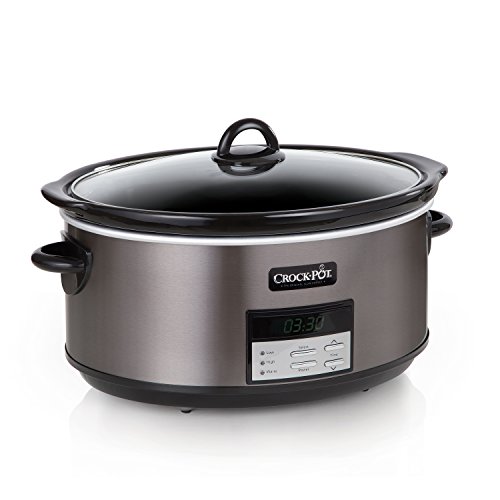
Here is what Hamilton Beach states about lead:
“Hamilton Beach specifications applicable to all slow cookers and their components (including the earthenware crocks) prohibits the product from containing any measurable amounts of lead. Furthermore, the factories that manufacture the earthenware crocks for Hamilton Beach are certified ceramic production facilities whose ceramic ware is deemed to satisfy FDA heavy metal requirements. Hamilton Beach takes all reasonable steps to ensure that the earthenware crocks accompanying our slow cookers provide safe and satisfactory service to our consumers.”
If you’re comfortable with this response then here are some of their top slow cooker options:
Hamilton Beach 6 quart portable with temperature probe

Here is what Kitchen Aid states when I asked about lead and slow cookers:
“Throughout our 111-year history, Whirlpool Corporation has been committed to providing safe products for our consumers. The company’s aluminum alloy stand mixer accessories, including beaters, dough hooks, and whisks, are tested through a third-party, independent laboratory to ensure they comply with all applicable regulations in the locations where they are sold regarding lead content. They are safe for any family’s cooking needs. In addition, all current models of aluminum stand mixer accessories have a food-safe coating over the aluminum that is tested both for lead content and lead migration to ensure that it is safe for all consumers.”
I then restated that I was asking about slow cookers and here is what they stated
“I want to reassure you that our products are safe. I can see that you still have concerns. I think it would be helpful to speak over the phone.” I haven’t called them yet so at this point I won’t recommend some of their options.
Stainless Steel Interior Slow Cookers
If you search for stainless steel slow cookers you will get tons of results, however it’s usually because the outside is made of stainless steel and not the interior where the food is being cooked. There are NOT many options when it comes to stainless steel materials, and I believe one of the reasons is because they are so dang expensive. If it’s important for you to minimize any risk of leaching trace amounts of lead then stainless steel could be an option for you if it works for your budget.
Wolf Gourmet Programmable 6-in-1 Multi Cooker with Temperature Probe

If price is not an issue, then this could be a great option if you are looking for a stainless steel interior. People rave about this product, and claim it’s one of the best slow/multi cooker options out there (slow cooker, rice cooker, saute/sear, sous vide (warm water bath). You can use the temperature probe to cook the food to the exact temperature you need. This is my dream option.
What about the Instant Pot?
Years ago I was on the search for a non-toxic slow cooker and the Instant Pot was a top recommendation since it has a stainless steel interior and has a slow cooker setting. So I made the purchase and when it came to slow cooking I was disappointed. It did not perform well. I had multiple failed attempts using the slow cooker to cook a meat dish, and I’m also not alone. The meat was undercooked after hours in the Instant Pot and was cooked according to the instructions. Maybe it has to do with the heating element locations, from my understanding ceramic crock pots tend to have heating elements on the side and bottom, and the Instant Pot has the heating element on the bottom.
Final Thoughts
Slow cookers are a great way to make meals with little effort but it is important to be aware of unwanted chemicals that could leach in to your food. Stainless steel and ceramic slow cookers both have their pros and cons when it comes so it’s up to you to decide what’s the best option for you and what fits with your budget. Don’t forget to be mindful of the type of food being cooked (avoid acidic food is possible) and the frequency of use to reduce exposure. I hope this article has helped you find the right slow cooker for your needs!

